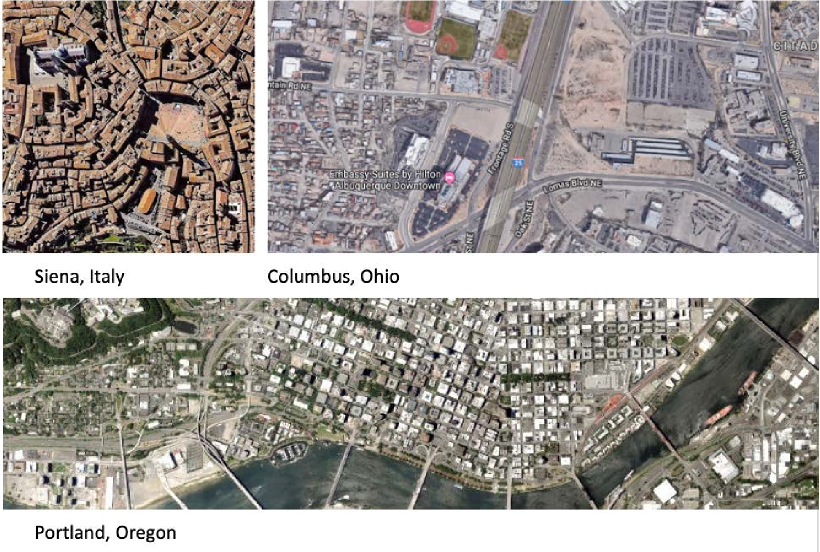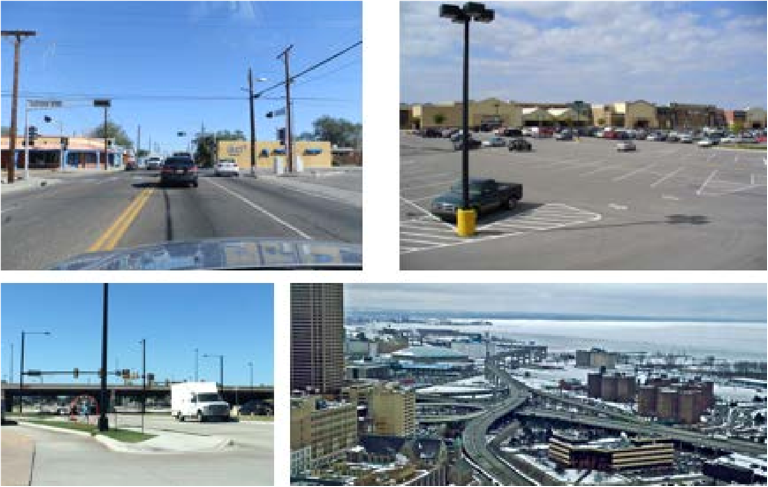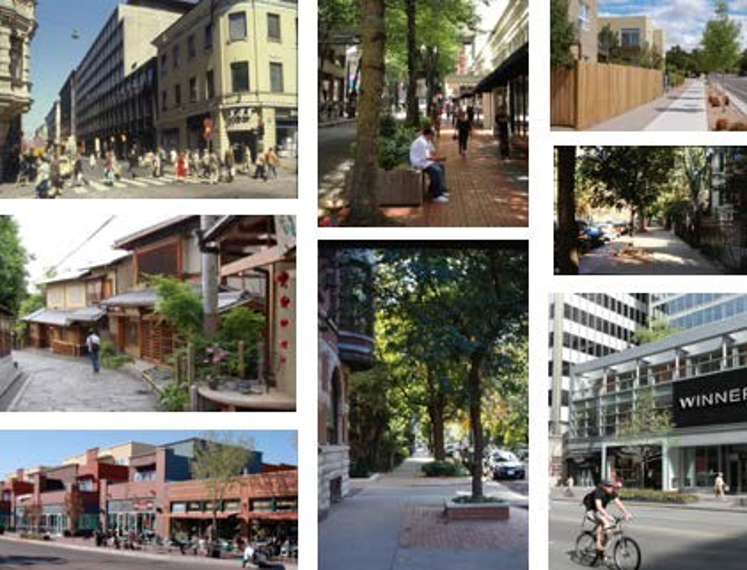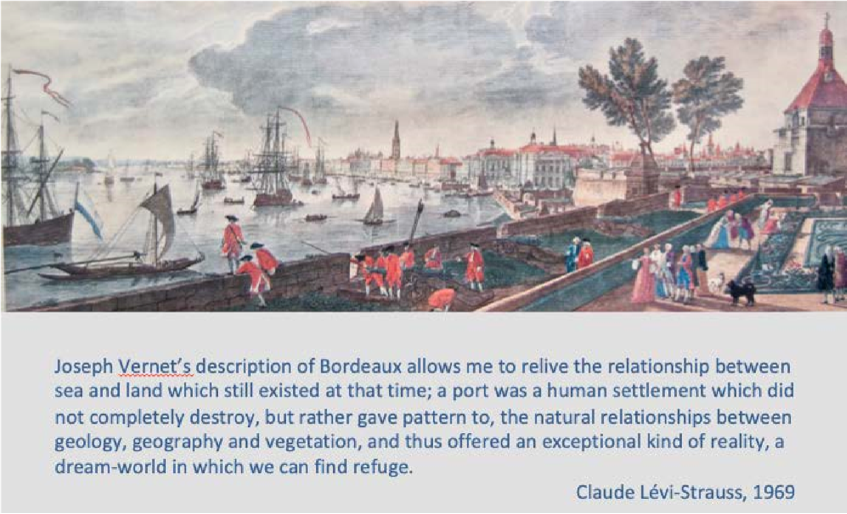Norman Crowe
University of Notre Dame and University of New Mexico
ncrowe@nd.edu
Introduction
The modern city—that is, the type of urban fabric that evolved for the most part after the late 1940s—presents a distinct departure from traditional urban form with respect to three conditions of continuity:
- spatial continuity of the overall urban fabric,
- temporal continuity among the constitute pieces of that fabric, and
- visual continuity with respect to normative perception of individual buildings.
This presentation looks at discontinuity in the modern city in contrast to relative continuity of the fabric of traditional urbanism, and it speculates on what may have been lost—that is, what are the unintended consequences of urban discontinuity. Finally, it suggests that we seek a new paradigm, one that more effectively re-asserts humanist values in both the built environment and in our collective idea of nature—which is seen here as integrally related to our idea of the city.

Fig. 1. Modern urban pattern with discontinuities (representative example of Columbus, Ohio), compared with traditional urban fabric (representative examples of Siena, Italy and central district of Portland, Oregon).
Abrupt Shift in the Pattern of Urban Fabric
If we had been able to observe the development of cities beginning just after the Second World War, say, from a satellite where we could watch the overall pattern as it developed, we would have seen cities change from a relatively continuous urban pattern into loosely fragmented pieces—chunks as it were of coherent urban fabric but now spatially intermittent. And at the same time we would have seen new suburban growth taking place at lower and lower densities as it spreads across existing natural and agricultural land. This new physical pattern as seen from our imaginary satellite view is in turn serviced by an expanding network of new vehicular arterials that promote so called leapfrog development, allowing chunks of urban pattern to take place at low suburban densities and without evident centers, spreading across existing agricultural and natural land remote from existing dense urban centers. At the same time we would have seen that the central areas of many large cities such as San Francisco, New York’s Manhattan, Portland, Oregon and the like (fig. 1), plus most all European cities, continued to maintain their traditional pattern though not without incursions at their edges. Meanwhile, existing urbanism between the dense center and new outer suburbs became increasingly fragmented by such land-consuming developments as big box shopping centers, freeways, extensive parking areas, and the like.
To gain a perspective of how quickly this change in urban form has taken place, imagine if you were to compress the last 10,000 years—that is roughly since the beginning of human settlement after the end of the last ice age—into 10 hours. That is, 10,000 years in 10 hours. Then the comparatively unique discontinuous fabric of modern urbanism would take place in the last four minutes. So, if we assume that the general formal characteristics of traditional urbanism evolved through incremental interaction with normative functional requirements and natural human neurophysiology in concert with the inherent structure of human social relationships, we might well expect those changes in urban form to generate certain unintended consequences. With that in mind, what follows is a look at the three conditions of discontinuity of the post-World War II city referred to above, and some conjectural estimates as to their effect.
1. Physical Discontinuity
Urban dwellers tend to regard their homes as sacred places for their families—that is ‘sacred’ as for instance Mercia Eliade described it: ‘not necessarily related to an organized religion, but conceptually sacred in response to innate sensibilities. We think of our homes as places of withdrawal, repose, and safety—the physical center of our personal world. And “center” is the operable term here. It has been that way since ancient times. In fact, its universality would suggest that a natural predisposition is at work here, one rooted in our DNA as something we share with other creatures. It has been explained as an evolutionary adaptation of our huntergather ancestors, driven to protect their offspring, perhaps temporarily hidden away in a cave somewhere from predators. Further, like other creatures whose den or nest or cave is encircled by an expanding territoriality of diminishing intensity moving out from the center, it follows that we extend the idea of domicile-as-sacred-place to the larger place of which it is a part, that is, the town or city where we live. It follows therefore that the new intermittency or characteristic discontinuity of modern urbanism may well inhibit the extent of the idea of sacred place as emanating from one’s domicile and extending to the city at large. In other words, that expanding circle is now more likely limited to something much smaller, such as the neighborhood for instance, rather than the city at large as it once did.

Fig. 2. Typical of physical discontinuity that disrupts the urban fabric of the modern city.
As an aside, it is important to note that not all dense urban fabric provides an ideal civic environment. Think for instance of what used to be referred to as “slums”. However, an arbitrarily torn fabric is not an alternative. Only the best of relatively dense well balanced mixed use urban conditions can provide for a positive urban life style and promote broader environmental efficiency at the same time. This is to say that the continuous traditional urban pattern or fabric is much more environmentally efficient than the more recent pattern of lower density urbanism—something we have all heard a lot about of late, even in the popular press.
2. Temporal Discontinuity
Characteristic of the modern city is that it is always changing—rebuilding to meet dynamic economic circumstances. The traditional city, by contrast, tended to be much less dynamic when it came to change. It underwent continuous change of course, but more like a kind of remodeling or renovation, taking place incrementally thereby leaving distinct palimpsests of what went before, in contrast to complete and rapid change as with in the modern city thanks to the efficiency of bulldozers, wrecking balls and the economic efficiency of a clean slate approach to large scale real estate development. Philosopher and phenomenologist Hannah Arendt for instance compared the temporal life of traditional cities with modern urbanism by contrasting the traditional city’s permanence as a sort of psychological hedge against human mortality.
Nowhere else does the sheer durability of the world of things appear in such purity and clarity . . . as in the non-mortal home for mortal beings. The man-made world of things, the human artifice erected by homo faber, becomes a home for mortal men, [its] stability will endure and outlast the ever-changing movement of their lives and actions.[1]
Her model was the mid-European city of stone, set in contrast with the modern city of easily demolished and replaced buildings of wood frame, steel, glass, and concrete.

Fig. 3. Visual continuity as a function of consistency of detail and spatial order accomplished through careful building and street design that regards the street as public corridor.
3. Visual Continuity
In the 1950s Kevin Lynch, among others, recognized the importance of the sense of visual continuity as a means to a harmonious urban environment. He spoke of it in his book Image of the City. In a list of characteristics of the well-designed city he included perceptual characteristics of continuity as follows:
Continuity: continuance of edge or surface (as street channel, skyline, or setback); nearness of parts (as a cluster of buildings); repetition of rhythmic interval (as a street-corner pattern); similarity, analogy, or harmony of surface, form, or use (as in a common building material or repetitive pattern of bay windows, similarity of market activity, use of common signs). These are qualities that facilitate the perception of a complex physical reality as one or as interrelated, the qualities which suggest the bestowing of a single identity.[2]
That last sentence is a complicated way of saying, ‘these are the sorts of things that provide for a sense of unity in a complex urban environment. (fig. 3 and 4)
Note also that his list is of items too subtle to be experienced from a speeding car in traffic; he traces instead, a pedestrian’s experience of the city. And it should be noted that the discontinuity of the modern city is not only a response to the automobile, modern economic systems with their inherent temporal dimension resulting from the impermanence of modern construction, but as Lynch’s list of perceptual characteristics would suggest it is also a factor in modern building design strategies. Since the advent of the Modern Movement in architecture building design has become increasingly focused on the building-as-object—with new buildings placed in context as independent objects, often without intentional relationship to subtle characteristics of their site.
This is to say that buildings designed as unrelated objects contribute as well to a sense of discontinuity of the urban fabric.

Fig. 4. Left: Proposal for North Mich. Ave. Chicago by architect Louis H. Sullivan office, c.1926, intended to encourage a common cornice height to promote a sense of continuity of the street as counter to the inevitable inclusion of high-rise towers in the wake of rapidly rising land values. Right: London’s evolving skyline today, composed of disparate high-rise buildings unrelated to each other or to the historic urban fabric around them.
None of this is new to us. I’ve sketched it here to provide a sort of overview, a reminder of what has been happening for the past 70 years or so. Many have written about the problem of the demise of harmonious urbanism, including Hannah Arendt and Kevin Lynch quoted in the foregoing. Others that will be familiar to you include landscape architect J.B. Jackson, urban pundit James Kunstler, architects and urbanists Andrés Duany, Jeff Speck, Dhiru Thadani, Peter Calthorpe, and Aldo Rossi, historians Spiro Kostof and Carroll William Westfall, sociologist E.V. Walter, architectural critics Witold Rybczynski, Robert Campbell, Blair Kamin, and Sarah William Goldhagen, and anthropologist Claude Levi-Strauss (fig. 5) . . . the list goes on.
As far as I am aware, extensive systematic scientific research has yet to be done regarding the character and extent of actual social and psychological damage attributable to discontinuity and related disharmonies of the cityscape. However, thoughtful people like those named here substantiate and recognize the existence of the problem regardless of whether or not it has been scientifically quantified.

Fig. 5. Reproduction of a mural by Joseph Vernet in a Railway station in Bordeaux, which anthropologist Claude Lévi-Strauss recalled from his youth.
The Need for a New Paradigm
I am convinced that, with or without detailed scientific analysis, it is obvious that the prevailing idea of a city must now yield to a new or newly revised ethos or paradigm, one that builds on humanist sensibilities that regard nature and the built-environment as parts of the same thing. Post-World War II planning policies designed to make cars happy needs to yield to more comprehensive strategies. Perhaps the ancient concept known as “harmony” can become an operable idea once again in spite of its subjective and unquantifiable nature. We know that for the first time in human history we are changing the whole of the planet by means of our own actions. Climate, habitats, the existence or extinction of other species—the whole of earth’s ecologies are undergoing change by human agency, a largely unintended consequence of our economic and technological prowess. It is not an exaggeration to say that we are in the midst of the second transition of humankind. The first was humanity’s transition from a life in nature as nomadic hunter-gathers to a life in settlements supported by agriculture and trade. That was the Neolithic Revolution that began more than ten thousand years ago. Some geologists have even suggested that we are now in the midst of a new geological age, the Anthropocene, where earth’s geology and ecosystems, including anthropogenic climate change, are the product of human activity.
Central to our existential being is the environment we build for ourselves to live within. It forms the fabric of our lives and in turn reflects the obvious as well as the hidden driving forces that shape our thoughts about our place in nature. To borrow scientist and humanist Loren Eiseley’s analogy of Odysseus’s voyage as the journey of humankind from the Neolithic Revolution to the present, our predicament “stands as . . . both man’s homelessness and his power, a power more unregenerate than that which drove Odysseus to string the great bow before the suitors.” The search to redirect our power to greater humanitarian purpose is, again according to Eiseley, “to know the dark beyond the stars before we comprehend the nature of our own journey.”[3]
Conclusion
Our second world, the built environment in which we once took refuge from the caprice of nature, stands at the heart of who we are. It reflects our highest aspirations as well as the dark side beyond the stars of our lesser nature. It is our habit today to think almost exclusively of the built environment as the thing that runs our economies which in turn provide us with the wealth and services that we want, but at the same time it also reflects our changing moral order, both our highest and lowest aspirations and all that lies between. Terms such as “beauty”, “harmony”, “nurturing”, “sacred” and “the humane” have retreated in the face of “efficiency”, “economy”, and “the quantifiable”. Those latter terms are of course not necessarily negative qualities—except when they are thought of as the exclusive means to measuring and evaluating the human condition. A new paradigm or ethos or story is up to us, but I think we all would agree that at its base must lie a sense of the transcendent in a rekindled unity of the man-made and nature— including human nature.
General References:
Arendt, Hannah, The Human Condition (Chicago: University of Chicago Press, 1958).
Atkin, Tony and Joseph Rykwert, ed’s., Structure and Meaning in Human Settlements (Philadelphia: Univ. of Pennsylvania Museum of Archaeology and Anthropology, 2005).
Barrie, Thomas, House and Home: Cultural Contexts, Ontological Roles (New York: Taylor & Francis Group, 2017).
Crowe, Norman, “Nature and the City: Biases in Conflict?” Bulletin of Science, Technology & Society, vol. 20, no. 4, Univ. of Toronto, Aug. 2000, p. 266–270.
Crowe, Norman, Nature and the Idea of a Man-Made World: An investigation into the Evolutionary Roots of Form and Order in the Built Environment (Cambridge: The M.I.T. Press, 1995).
Goldhagen, Sarah Williams, Welcome to your World: How the Built Environment Shapes our Lives (New York: Harper Collins Publishers, 2017).
Jackson, John B., A Sense of Place, A Sense of Time, (New Haven: Yale Univ. Press, 1994).
Kostof, Spiro, The City Shaped: Urban Patterns and Meanings Through History (Boston: Little Brown and Co., 1991).
Kunstler, James Howard, The Long Emergency: Surviving the Converging Catastrophes of the Twenty-First Century (New York: Atlantic Monthly Press, 2005).
Lawlor, Anthony, The Temple in the House: Finding Sacred in Everyday Architecture (New York: G. P. Putnam and Sons, 1994).
Lynch, Kevin, The Image of the City (Boston: The MIT Press, 1960).
Rossi, Aldo, The Architecture of the City (Cambridge: MIT Press, 1992).
Rybczynski, Witold, City Life: Urban Expectations in a New World, (New York: Scribner and Sons, 1995).
Rykwert, Joseph, The Seduction of Place: The City in the Twenty-first Century, (New York: Pantheon Books, 2000).
E.V. Walter, Placeways: A Theory of the Human Environment, (Chapel Hill and London: The University of North Carolina Press, 1988).
Credits, Illustrations:
fig. 1. Google Earth fig. 2. above: N. Crowe; below: CNU Journal (on-line) 03-17-19. fig. 3. N. Crowe
fig. 4. left: Courtesy Art Institute of Chicago, Sullivan Archives; right: Picasa / IPTC Photo Metadata fig. 5. tipped-in print based on mural by Joseph Vernet, c.1880. (with statement by Levi-Strauss added).
[1] Hannah Arendt, The Human Condition (Chicago: University Chicago Press, 1958). 167-168.
[2] Kevin Lynch, The Image of the City (Cambridge: The M.I.T. Press, 1960). 106.
[3] Loren Eiseley, The Unexpected Universe (New York: Harcourt, Brace & World, Inc., 1969). 25-25.



